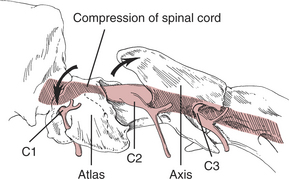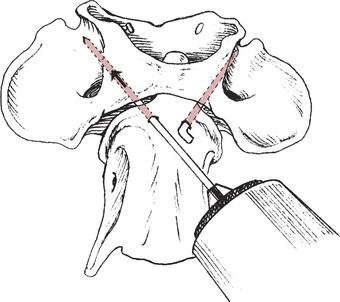Chapter 100 Fractures and Dislocations of the Spine
Congenital and acquired diseases of the spine are seen frequently in small animal practice. Early diagnosis and effective treatment are crucial for success in preservation or return of normal neurologic function in these patients.
ATLANTOAXIAL INSTABILITY
Anatomy
Etiology
Atlantoaxial instability can arise from either congenital or acquired etiologies.
Clinical Signs
Diagnosis
Surgical Procedures
Preoperative Considerations
Technique
Dorsal Approach (Overview)
Ventral Approach
Postoperative Care and Complications
CAUDAL CERVICAL SPONDYLOMYELOPATHY
Anatomy
Etiology
Pathologic Changes Associated with Wobbler’s Syndrome
Congenital Osseous Malformation
Vertebral Tipping
Chronic Degenerative Disc Disease and Cervical Vertebral Instability
Ligamentum Flavum Hypertrophy
Hourglass Compression
Clinical Signs
Diagnosis
Differential diagnoses include degenerative spinal cord disease, ischemic myelopathy, discospondylitis, congenital spinal cord disease, inflammatory central nervous system disease, spinal neoplasia, brachial plexus tumor, subarachnoid cysts, and trauma (see Chapter 128). Ischemic myelopathy (also called fibrocartilaginous embolization) can usually be ruled out because this process is not associated with cervical pain (see Chapter 128).
Diagnostic Imaging
Myelography
Stay updated, free articles. Join our Telegram channel

Full access? Get Clinical Tree




